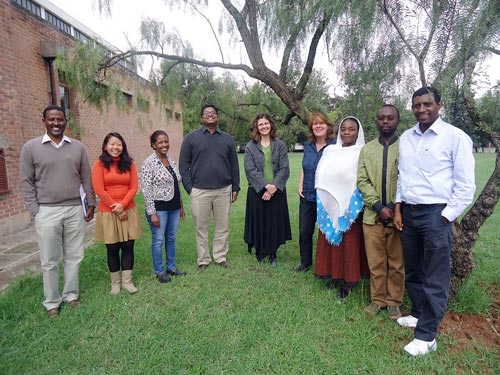 Exploring the potential for integrating gender at a range of scales in the work of the CIMMYT-CCAFS modeling team, members of the team accompanied by colleagues from the International Water Management Institute (IWMI) gathered in Addis Ababa, Ethiopia, on 4 July 2013 for a half-day explanatory CIMMYT-CCAFS Gender and Modeling Workshop. The workshop was organized by gender consultant Cathy Farnworth as part of a wider drive to bring gender into CIMMYT-CCAFS work.
Exploring the potential for integrating gender at a range of scales in the work of the CIMMYT-CCAFS modeling team, members of the team accompanied by colleagues from the International Water Management Institute (IWMI) gathered in Addis Ababa, Ethiopia, on 4 July 2013 for a half-day explanatory CIMMYT-CCAFS Gender and Modeling Workshop. The workshop was organized by gender consultant Cathy Farnworth as part of a wider drive to bring gender into CIMMYT-CCAFS work.
The workshop began with a series of presentations, first of which was by IWMI hydrologist Tracy Baker. Baker focused on ‘Incorporating gender and other perceptions into physically based modeling environments,’ emphasizing that incorporating gender into modeling was part of a wider need to integrate the complexities of human nature into models. Gender incorporation can improve models because women and men use landscapes in different ways, Baker stressed, pointing out Participatory Geographic Information System (PGIS) modeling as one option that may offer insights into gendered uses of landscape. Baker demonstrated gendered uses and perceptions of landscape through a case study of her own work in Kenya, in which she showed that women and men use the same landscape in very different ways.
CIMMYT climate economist Songporne Tongruksawattana discussed ‘Gender issues in farm household modeling’ describing a typical household model and the challenges climate change poses for intra-household decision-making.
CIMMYT’s crop modeler and GIS specialist Kindie Tesfaye presented work on ‘Biophysical and economic modeling at scale,’ conducted by himself, Sika Gbegbelegbe, Uran Chung, and Kai Sonder, and focused on simulating climate change impacts and scenarios and the role of promising technologies at different spatial and temporal scales. He concluded his presentation by listing pertinent questions on the opportunities and challenges of incorporating gender into biophysical and economic modeling.
CIMMYT’s agricultural anthropologist Michael Misiko’s work was titled ‘Handling gender issues in agriculture: A tricky balance between biophysical and social facets’, and examined how mechanization in conjunction with the promotion of conservation agriculture (CA) exposes gender relations in farming systems and can lead to both opportunities and new inequalities between women and men. He pointed out that while machines and tools are not gendered and can be used equally by women and men, in practice women are frequently not able to take advantage of machinery. From a purely technical point of view CA should be ideal for women, since it should minimize drudgery, particularly weeding, but in reality women’s tasks are often hard to mechanize due to their intrinsic nature, women’s often small and scattered plots, and because women are not a target priority group for mechanization by extension agents.
The workshop continued with a group discussion led by Baker. Issues raised and discussed included: How to ask the right questions at the right scale? How can we combine PGIS derived maps created by women/men and different ethnic communities? Whose voices are prioritized? Who participates and why? Who decides who participates? Whose reality are you trying to capture?
Participants then discussed ways forward and agreed to create a gender and modeling taskforce and a cross-CGIAR forum for discussion and engagement; they hope to follow up with another, larger-scale, workshop in 2014. Later, CIMMYT-CCAFS modeling team members discussed how to strengthen gender in their work plans.
 Capacity development
Capacity development